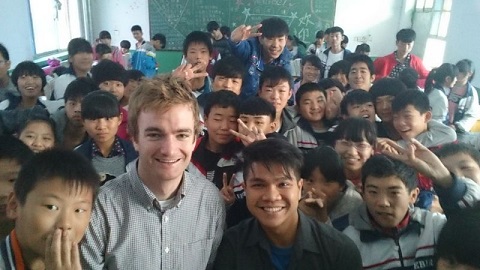The excitement rippled through the school. First it spread across the playground and then up the stairwells onto the balconies which overlooked it. We had just arrived at Pingxiang Middle School in Hebei province and we had not gone unnoticed. Our group of Tsinghua student was made up of two Chinese members, two Singaporeans and one from the UK, myself. We had come as part of the university’s outreach program to rural schools and everyone was excited for us to be there, first as representatives from a prestigious school and secondly as a few of us were foreigners in a town where there weren’t many. The students treated us at first with the awe of a novelty but would soon warm to our presence.

We had come to Pingxiang with a specific goal in mind: the students in year 8 were preparing for the zhongkao (中考) exam at the start of summer and we had come, as students who were already at a university where many of them hoped to end up, to give them advice on how to best prepare for these crucial exams. As Chinese speakers, the other Tsinghua students were to give classes on how to prepare for exams and on life at university. With my limited Chinese I could not offer these valuable insights and so would instead be teaching an English class on story writing with the theme of ‘overcoming adversity’.
I prepared my class around the story of my trip this summer cycling from Hong Kong to Beijing. On the journey I had encountered landslides, severe flooding, temperatures in excess of 40?C, dangerous drivers and crumbling roads (some of which disappeared into mud tracks). I told the students about these trials but also about the value I found of pushing through them for the rewards of beautiful landscapes, charming strangers and places off the tourist circuit which were rich in culture and steeped in history. I also had the students create short sentences to tell the story of their own experiences learning to ride a bicycle and taught a few new adjectives by having them describe the classical Chinese hero Guanyu (关羽).
The lesson seemed to be well received by the students and teachers with whom we had a meeting to discuss teaching techniques and student motivation. They were curious to know how we had approached our own studies at the same age and to hear how approaches to teaching in Singapore and the UK differed to common practice in China. Amongst other questions, they asked us: “how did you avoid the decline in motivation that students typically show as they become teenagers?” and “what is the best way to practice listening comprehension when learning a foreign language?”. What struck me most was just how similar these are to the concerns facing teachers in the UK; separated by half the world, educators in both countries were trying to face up to the flaws and opportunities that define our common humanity.
As I am not a teacher myself and have limited experience in the field, I felt inadequately qualified to offer sound technical advice but hopefully my descriptions of education practices in England were of some use as a source of new ideas from which the assembled teachers could draw the most appropriate lessons on their own. The one that I hope that they take the most heed of is the need to encourage creative thinking amongst students who are often taught by rote. The global society to which they will be exposed in the coming decades is one of unprecedented challenges and we will all need to be able to adapt in order to thrive.

Visiting the school was also a learning experience for me. We had been sent to this school in particular because it was one of those within the province that struggled. In part, this was due to poor infrastructure, evident in the lack of facilities (such as a large room in which to hold school meetings – we had to hold our farewell Q&A session in the square outside the canteen), the dilapidated decorations, uninspiring in their drabness, and the brutal utilitarianism of existing amenities. For example, the cavernous canteen had no chairs as the hundreds of students needed to all fit inside and would eat faster if standing. To see the spirit and determination with which the teachers and students approached their studies in spite of these challenges was inspiring but it begged the question why some schools had been left so far behind when others had had better facilities and refurbishments offered to them, as we were told by the teachers that they had.
I am grateful to have been offered this opportunity to travel to rural China to see what education looks like for many ordinary middle school students. I learned much from the trip and hope that I left a positive impression with those pupils with whom I came in contact. Many obstacles must be overcome if China is to improve educational provision in rural areas to the world-beating standards that it has set in major cities like Shanghai. I saw enough in Pingxing to believe that the raw potential is there, it is now a question of raising the standards of infrastructure across the board to those set in the best urban schools and to re-examine some of the approaches to education to ensure that the new generation is ready to provide the creative solutions that China will need in the 21st century.